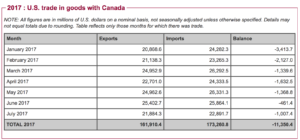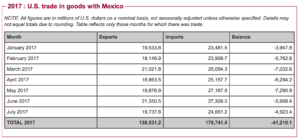The North Atlantic Free Trade Agreement is probably one of the biggest trade deals in the world, linking Canada, Mexico and the United States together. The deal has been in place since 1994, but now as it is being renegotiated its fate isn’t so clear.
NAFTA essentially encourages trade between countries by lowering tariffs on goods. Lowering tariffs makes goods cheaper because production can be easily outsourced and importing countries can easily take advantage of another country’s comparative advantage.
Unfortunately it hurts the manufacturing sector in the United States because there is cheaper labor in Mexico and U.S. companies don’t have to worry about paying an arm and a leg to get the assembled parts across the border.
For example, the U.S. Commerce Department is entertaining a tariff on imports of commercial planes of 220 percent to protect Boeing from their Canadian competitor.
Donald Trump has made it his goal to re-draft NAFTA to help support American workers and reduce the United States’ trade deficit with Mexico and Canada, both of which add up to about 52 billion dollars, less than a quarter of a percent of America’s GDP. But at the same time, there’s no argument NAFTA helps the consumer.
There are a few issues that the U.S. is trying to renegotiate, but the two biggest are rules of origin and article 19 on arbitration of trade disputes. Rules of origin basically means that country “a” can export to country “b” with limited tariffs only if country “b” is part of NAFTA. Article 19 allows any trade grievances one country has with another country to be reviewed by a panel, and if they deem necessary, that panel can ask the relevant parties to negotiate a valid solution.
And Trump wants to add a sunset provision to the agreement, meaning that NAFTA will no longer be in effect after five years unless action is taken to renegotiate it. The problem with that idea is it creates a lot of uncertainty but it also allows the member countries (Canada, Mexico and the U.S.) to fix any potential problems that may arise with specific parts of the agreement.
Negotiators are hoping to renegotiate NAFTA before the end of the year, which may be difficult considering the diversity of each country’s economy. In the first three talks, no real progress has been made regarding article 19, the sunset clause or rules of origin.
There’s no doubt NAFTA is good for consumers, but since manufacturing is an important part of the American economy and Trump made campaign promises to protect the manufacturing industry, there’s no guarantee the renegotiation will be successful.
Sources:
https://www.forbes.com/sites/johnbrinkley/2017/10/02/trump-administration-goes-after-canadian-aircraft-maker-during-nafta-talks-why/#6f27890e27b9
http://money.cnn.com/2017/08/20/news/economy/nafta-negotiations/index.html
http://www.sice.oas.org/Trade/NAFTA/chap-191.asp
https://www.bloomberg.com/news/articles/2017-09-14/ross-says-u-s-wants-five-year-sunset-provision-for-nafta


Leave a Reply
You must be logged in to post a comment.